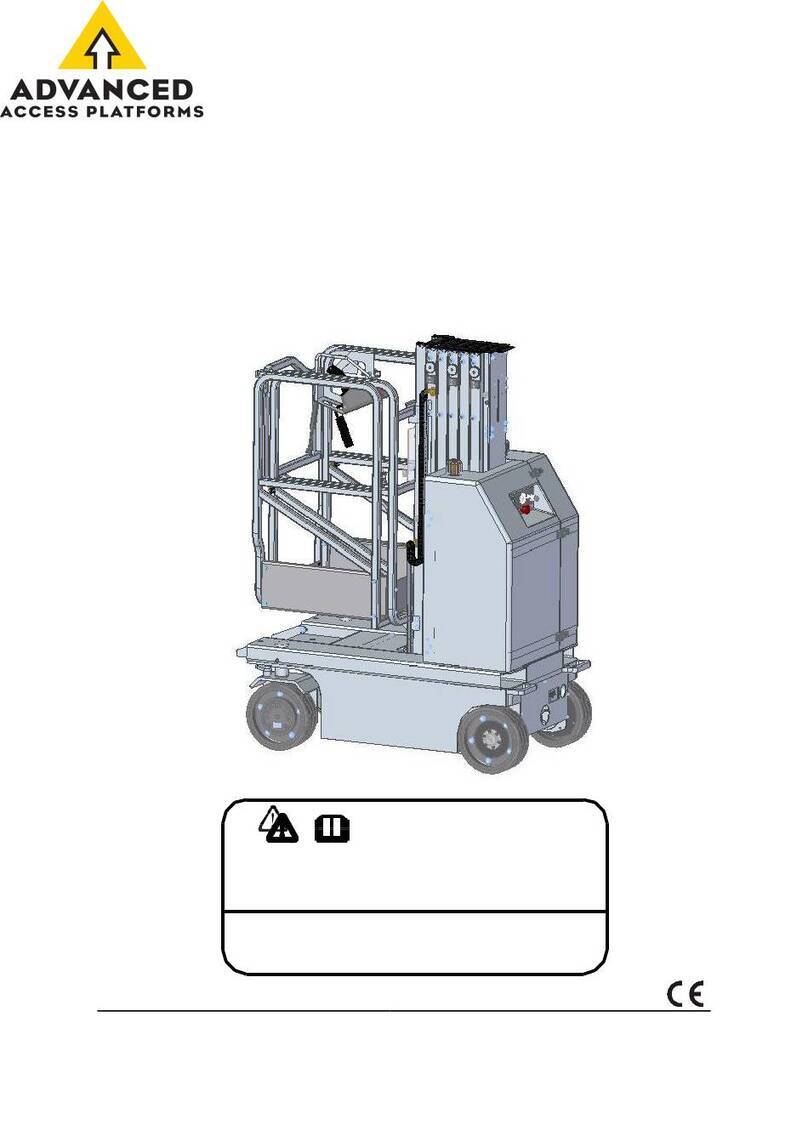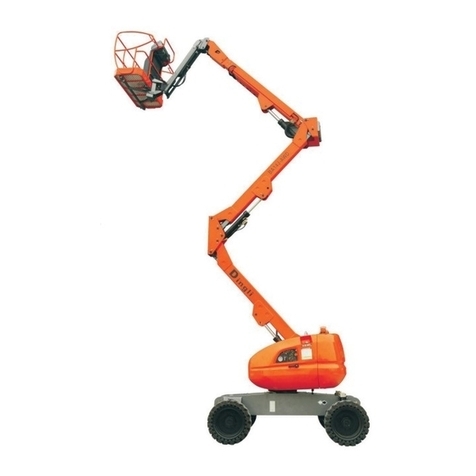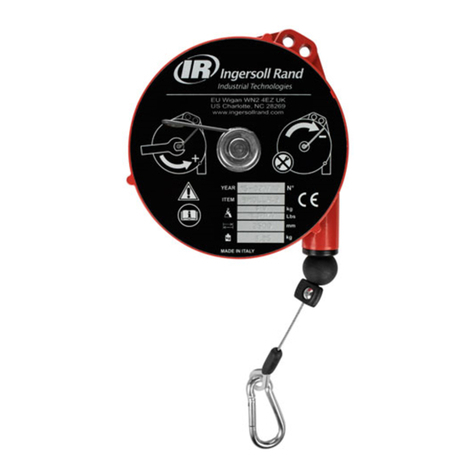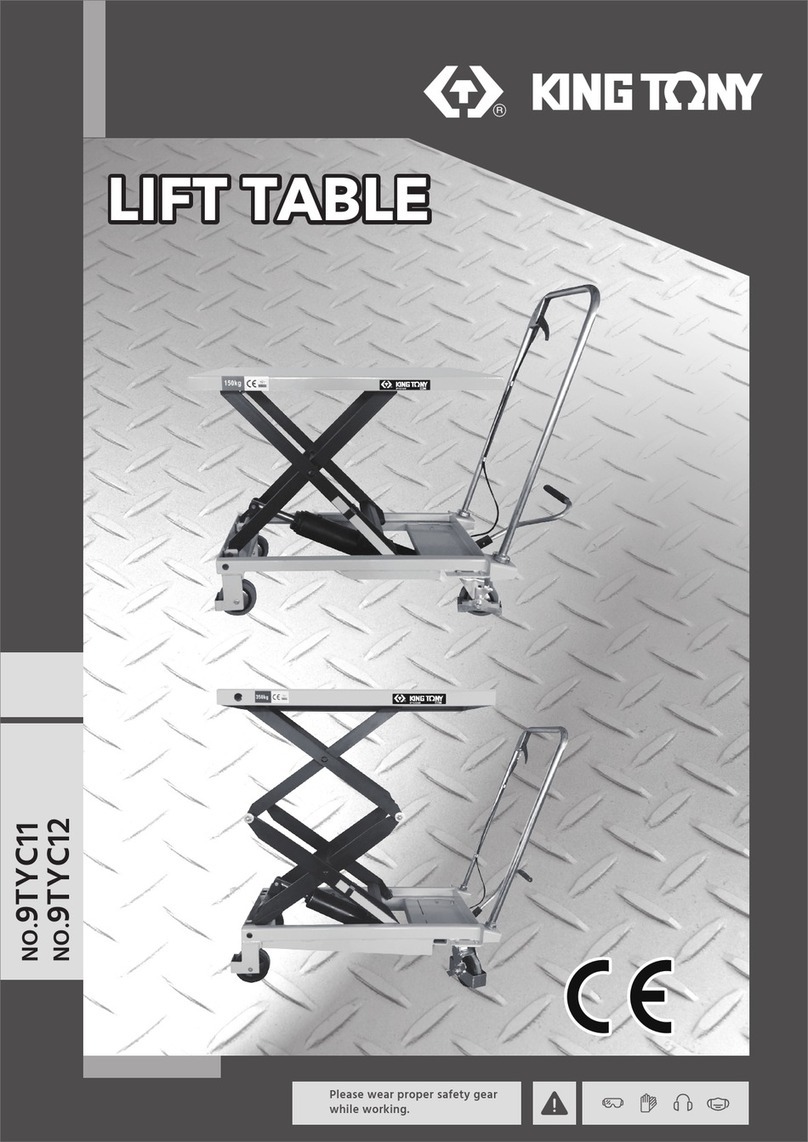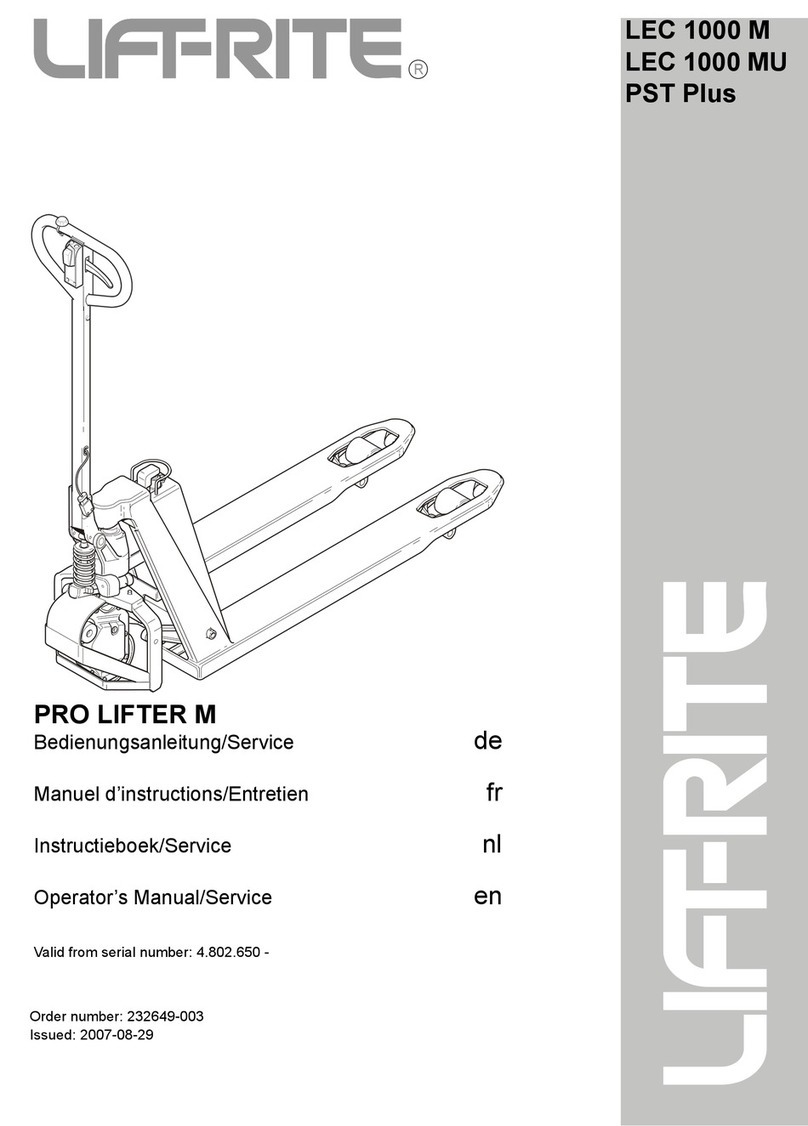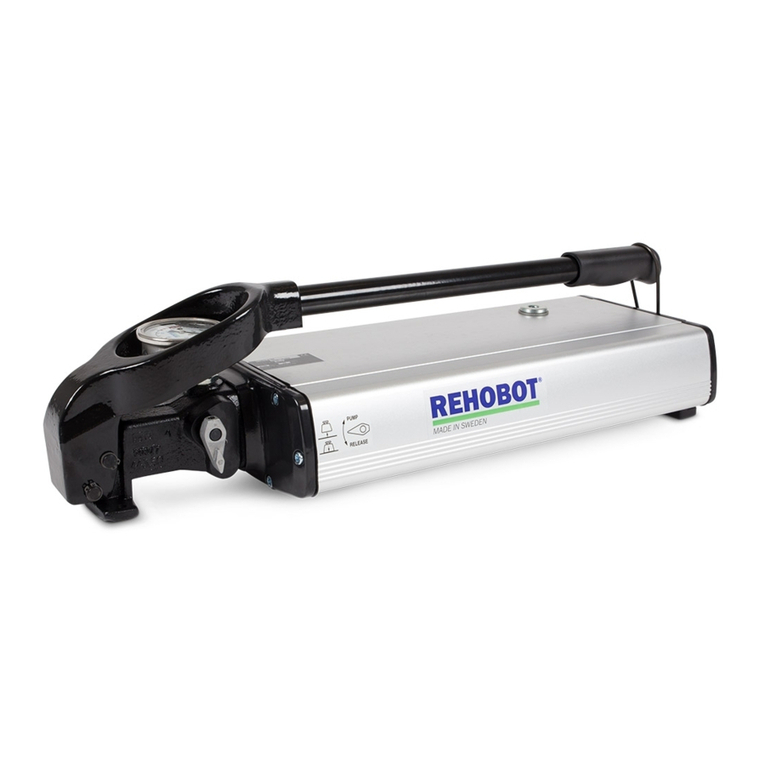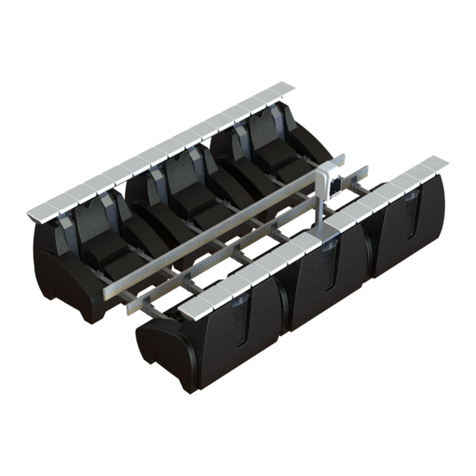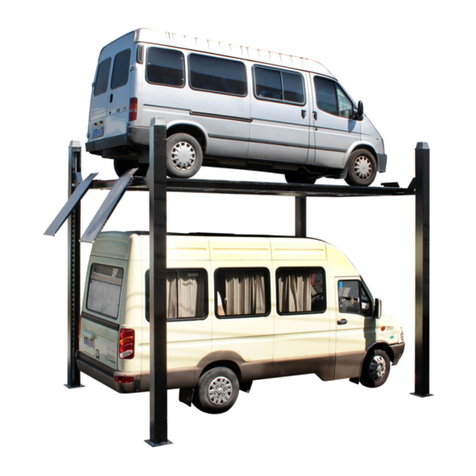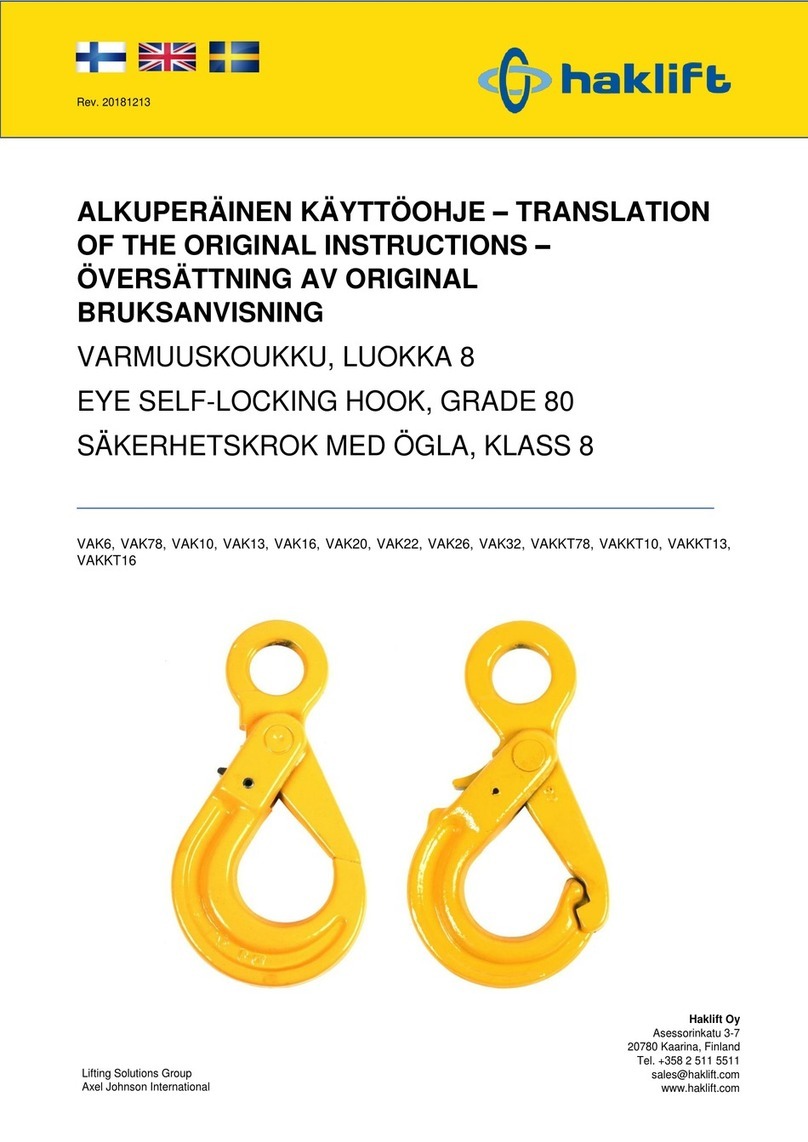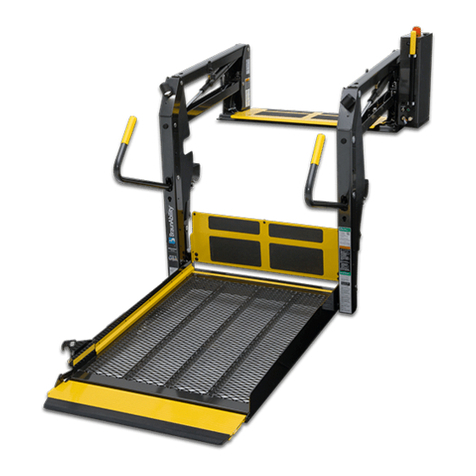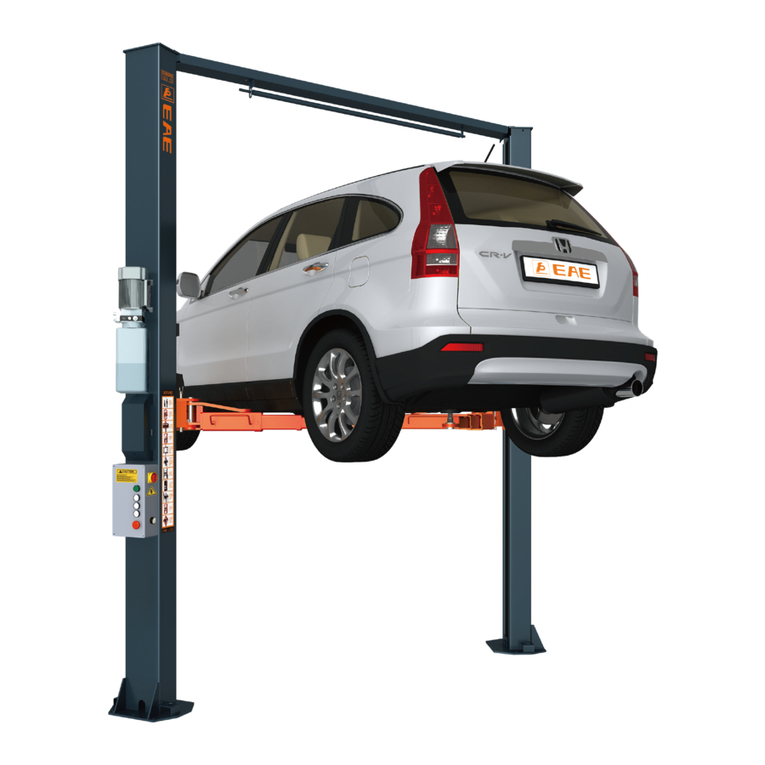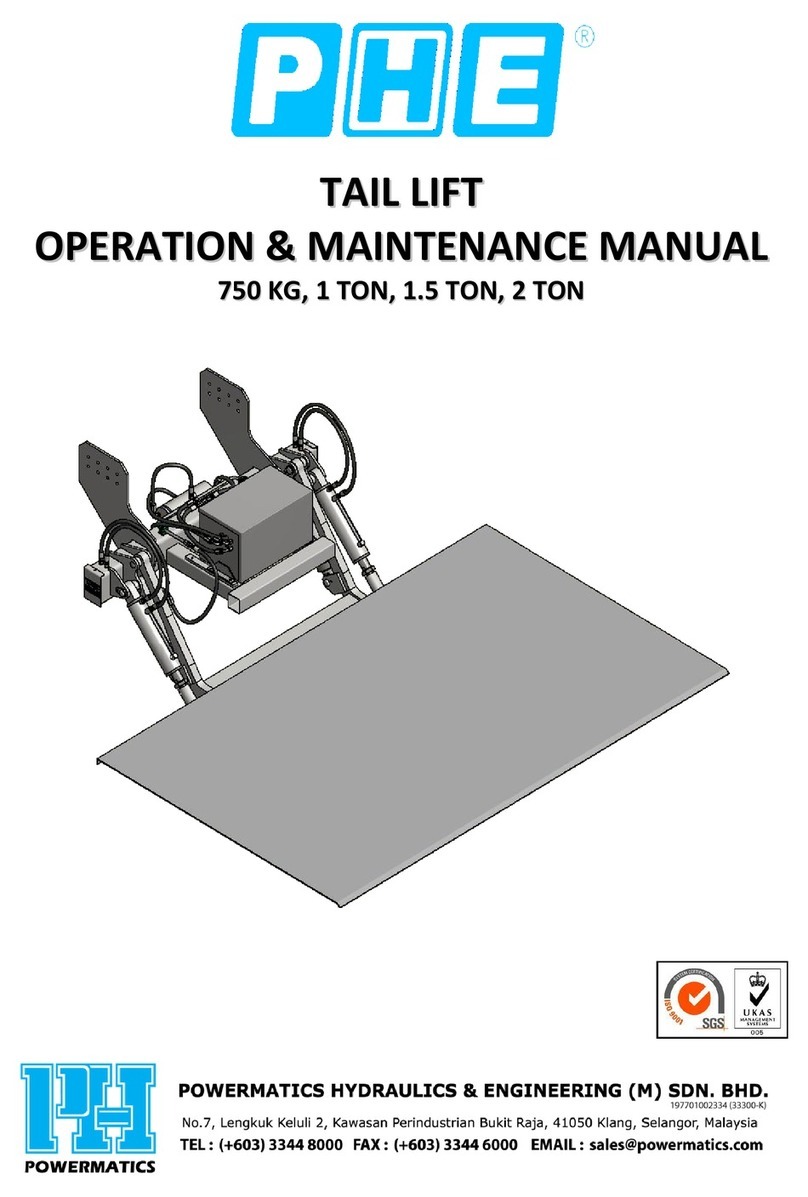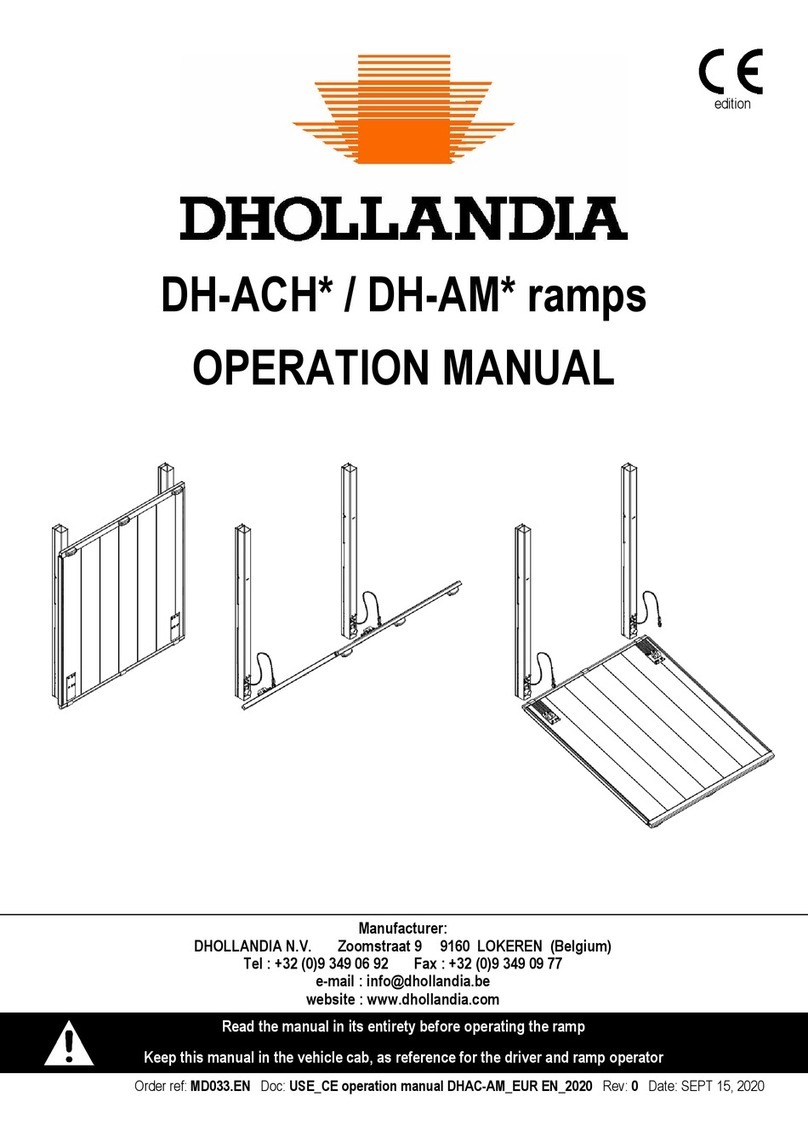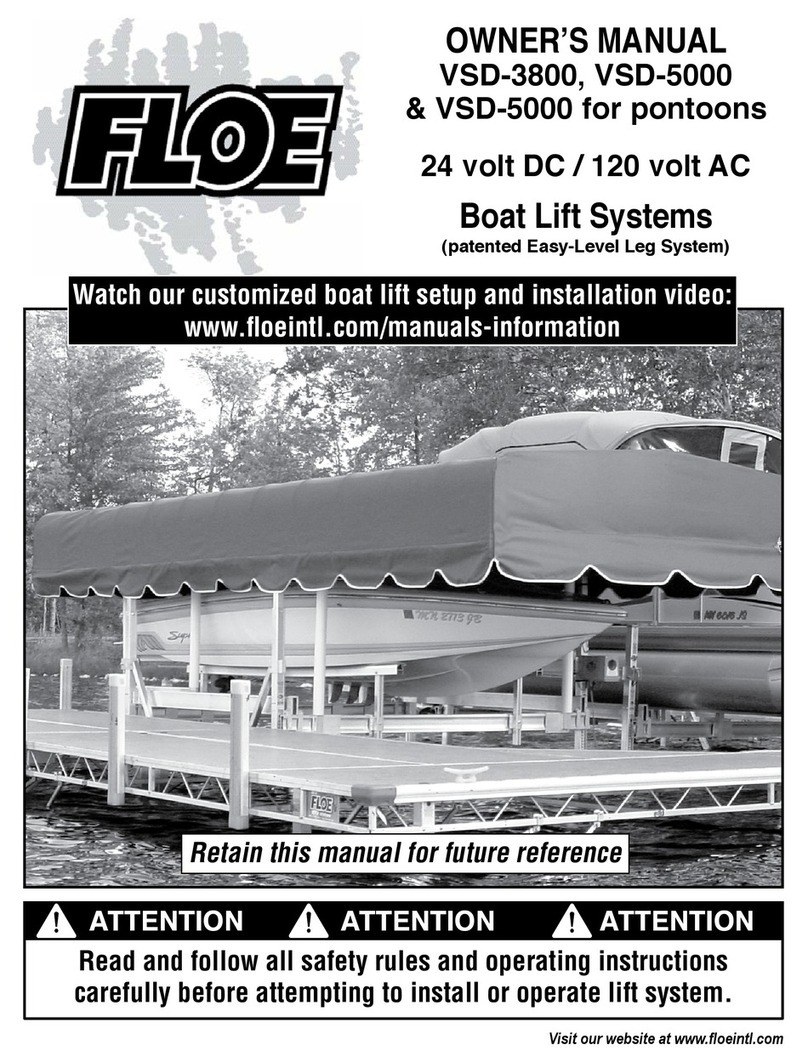DINGLI GTWY8-1200 Series Setup guide

AERIAL WORK PLATFORM
OPERATOR’S MANUAL
with Maintenance Information
(GTWY8-1200/ GTWY10-1200/ GTWY12-1200/ GTWY14-1200 Series)
Zhejiang Dingli machinery Co., Ltd. 2012-12

Important
Read, understand and obey these safety rules and operating instructions before operating this
machine. Only trained and authorized personnel shall be permitted to operate this machine. This
manual should be considered a permanent part of your machine and should remain with the
machine at all times. If you have any questions, call DINGLI MACHINERY.
Contents
Page
Safety Rules ................................................................................................................................ 1
Controls ..................................................................................................................................... 5
Illustration ...................................................................................................................................6
Pre-operation Inspection.............................................................................................................7
Maintenance ...............................................................................................................................9
Function Tests ...........................................................................................................................11
Workplace Inspection ................................................................................................................14
Operating Instructions ...............................................................................................................15
Battery Charging Instructions ....................................................................................................17
Transport Instructions ...............................................................................................................18
Tilt-back Operation Instructions ................................................................................................21
Decals .......................................................................................................................................23
Specifications ............................................................................................................................24
Hydraulic Diagram ....................................................................................................................25
Electrical Diagram ....................................................................................................................26
Inspection and Repair Log..........................................................................................................28
Contact us:
Zhejiang Dingli Machinery Co., Ltd
Address:No.1255 Baiyun South Road, Leidian Town, Deqing, Zhejiang China
Tel: 0086-572-8681688
Fax: 0086-572-8681690
E-mail:[email protected]
Http://www.cndingli.com.cn

Operator’s Manual
Safety Rules
GTWY1200 SERIES 1
Danger
Failure to obey the instructions and
safety rules in this manual will
cause death or serious injury.
Do Not Operate Unless:
You learn and practice the principles of
safe machine operation contained in this
operator's manual.
1 Avoid hazardous situations.
Know and understand the safety rules
before going on to the next section.
2 Always perform a pre-operation inspection.
3 Always perform function tests prior to use.
4 Inspect the workplace.
5 Only use the machine as it was intended.
You read, understand and obey the
manufacturer's instructions and safety
rules— safety and operator's manuals and
machine decals.
You read, understand and obey
employer's safety rules and worksite
regulations.
You read, understand and obey all
applicable governmental regulations.
You are properly trained to safely operate
the machine.
Electrocution Hazards
This machine is not electrically insulated and
will not provide protection from contact with or
proximity to electrical current.
Keep away from the machine if it contacts
energized power lines or becomes electrically
charged. Personnel on the ground or in the
platform must not touch or operate the
machine until energized power lines are shut
off.
Maintain safe distances from electrical power
lines and apparatus in accordance with
applicable governmental regulations and the
following chart.
Minimum Safe Voltage Approach Distance
Phase to Phase Feet Meters
0 to 300V Avoid Contact
300V to 50KV 10 3.05
50KV to 200KV 15 4.60
200KV to 350KV 20 6.10
350KV to 500KV 25 7.62
500KV to 750KV 35 10.67
750KV to 1000KV 45 13.72
Allow for platform movement, electrical line
sway or sag and movement due to strong or
gusty winds.
Do not use the machine as a ground for
welding.

Operator’s Manual
Safety Rules
GTWY1200 SERIES 2
Do not operate an AC powered machine or a
DC battery charger unless using a 3-wire
grounded extension cord connected to a
grounded AC circuit. Do not alter or disable
3-wire grounded plugs.
Tip-over Hazards
Do not raise the platform unless the base is
level, all four outriggers are properly installed
and the leveling jacks firmly contact the floor.
Do not adjust or remove the outriggers while
the platform is occupied or raised.
Do not move the machine while the platform is
raised.
Do not place ladders or scaffolds in the
platform or against any part of this machine.
Do not place or attach overhanging loads to
any part of this machine.
Do not transport tools and materials unless
they are evenly distributed and can be safely
handled by the person in the platform.
Do not raise the platform unless the machine
is level. Do not set the machine up on a
surface where it cannot be leveled using only
the leveling jacks.
Do not cause a horizontal force or side load to
the machine by raising or lowering a fixed or
overhanging load.
Do not push off or pull
toward any object outside
the platform.
Maximum allowable side force 200N
Do not operate the machine near drop-offs,
holes, bumps, debris, unstable or slippery
surfaces or other possible hazardous
conditions.
Do not alter or disable machine components
that in any way affect safety and stability.
Do not replace items critical to stability with
items of different weight or specification. Use
only Dingli authorized replacement parts.
Do not push the GTWY1200 series from the
platform side of the machine.
When moving the machine with a forklift or
other transport vehicle, the platform should be
fully lowered, the machine should be turned off
and no personnel shall remain in the platform.
Do not use the machine on a moving or mobile
surface or vehicle.
Do not operate the machine in strong or gusty
winds. Do not increase the surface area of the
platform or the load. Increasing the area
exposed to the wind will decrease machine
stability.
Occupants, equipment and materials shall not
exceed the maximum platform capacity.

Operator’s Manual
Safety Rules
GTWY1200 SERIES 3
Maximum capacity
GTWY8-1200 350 lbs 150 kg
GTWY10-1200 350 lbs 150 kg
GTWY12-1200 350 lbs 150 kg
GTWY14-1200 300 lbs 136 kg
Maximum occupancy 1 person
Fall Hazards
The guard rail system provides fall protection.
If occupants of the platform are required to
wear personal fall protection equipment (PFPE)
due to job site or employer rules, PFPE
equipment and its use shall be in accordance
with the PFPE manufacturer’s instructions and
applicable governmental requirements.
Do not sit, stand or
climb on the platform
guard rails. Maintain a
firm footing on the
platform floor at all
times.
Do not exit the platform while raised. If a
power failure occurs, have ground personnel
activate the manual lowering valve.
Keep the platform floor clear of debris.
Lower the platform entry mid-rail before
operating.
Collision Hazards
Operators must comply with employer, job site
and governmental rules regarding the use of
personal protective equipment.
Check the work area for overhead obstructions
or other possible hazards.
Be aware of crushing hazard when grasping
the platform guard rail.
Do not lower the platform unless the area
below is clear of personnel
and obstructions.
Stay clear of descending
platform.
Use common sense and
planning to control the movement of the
machine on or near inclines.
Improper Use Hazard
Do not leave the machine unattended unless
the key is removed to secure from
unauthorized use.
Bodily Injury Hazard
Do not operate the machine with a hydraulic oil
leak. An hydraulic leak can penetrate and/or
burn skin.

Operator’s Manual
Safety Rules
GTWY1200 SERIES 4
Explosion and Fire Hazard
Do not operate the machine or charge the
battery in hazardous locations or locations
where potentially flammable or explosive
gases or particles may be present.
Damaged Machine Hazards
Do not use a damaged or malfunctioning
machine.
Be sure all maintenance has been performed
as specified in this manual and the Dingli
GTWY Series service manual.
Be sure all decals are in place and legible.
Be sure the operator’s manuals are complete,
legible and in the storage container located on
the platform.
Conduct a thorough pre-operation inspection
of the machine and test all functions before
each work shift. Immediately tag and remove
from service a damaged or malfunctioning
machine.
Do not use the machine as a ground for
welding.
Battery and Charger
Safety-DC
Burn Hazards
Batteries contain acid.
Always wear protective clothing and eye wear
when working with batteries.
The battery pack must remain in an upright
position.
Avoid spilling or contacting battery acid.
Neutralize battery acid spills with baking soda
and water.
Explosion Hazards
Batteries emit explosive gas. Keep sparks,
flames and lighted tobacco away from the
battery.
Charge the battery in a well ventilated area.
Do not disconnect charger DC output wires
from the battery when the charger is on.

Operator’s Manual
Controls
GTWY1200 SERIES 5
Ground Controls
65 4
12 3
Platform Controls
67 8
1. Power light 2. Circuit breaker
3. Outrigger interlock display lights (four) 4. Up/down switch
5. Key switch 6. Red Emergency Stop button
7. Up/down switch 8. Control activate button

Operator’s Manual
Illustration
GTWY1200 SERIES 6
Illustration
11
3
1
2
16
17
7
4
5
15
8
10
6
12
13
14
9
18
○
1Tilt-back strut ○
7Winching/tie-down point ○
13 Outrigger with leveling jack
○
2Battery box ○
8Manuals storage ○
14 Outrigger lock pin
○
3Lifting eye ○
9Sliding T-handle ○
15 Mast
○
4Hydraulic power unit ○
10 Harness anchor ○
16 Forklift socket
○
5Ground controls ○
11 Tilt-back frame ○
17 Winching/tie-down point
○
6Platform entry mid rail ○
12 Platform ○
18 Base

Operator’s Manual
Pre-operation Inspection
GTWY1200 SERIES 7
Do Not Operate Unless:
You learn and practice the principles of
safe machine operation contained in this
operator’s manual.
1 Avoid hazardous situations.
2 Always perform a pre-operation
inspection.
Know and understand the pre-operation
inspection before going on to the next
section.
3 Always perform the function tests prior to
use.
4 Inspect the workplace.
5 Only use the machine as it was intended.
Fundamentals
It is the responsibility of the operator to
perform a pre-operation inspection and routine
maintenance.
The pre-operation inspection is a visual
inspection performed by the operator prior to
each work shift. The inspection is designed to
discover if anything is apparently wrong with a
machine before the operator performs the
function tests.
The pre-operation inspection also serves to
determine if routine maintenance procedures
are required. Only routine maintenance items
specified in this manual may be performed by
the operator.
Refer to the list following and check each of
the items.
If damage or any unauthorized variation from
factory delivered condition is discovered, the
machine must be tagged and removed from
service.
Repairs to the machine may only be made by
a qualified service technician, according to the
manufacturer's specifications. After repairs are
completed, the operator must perform a
pre-operation inspection again before going on
to the function tests.
Scheduled maintenance inspections shall be
performed by qualified service technicians,
according to the manufacturer's specifications
and the requirements listed in the
responsibilities manual.

Operator’s Manual
Pre-operation Inspection
GTWY1200 SERIES 8
Pre-operation Inspection
Be sure that the operator’s manuals are
complete, legible and in the storage
container located on the platform.
Be sure that all decals are legible and in
place. See Decals section.
Check for battery fluid leaks and proper
fluid level. Add distilled water if needed.
See Maintenance section. (DC models)
Check for hydraulic oil leaks and proper
oil level. Add oil if needed. See
Maintenance section.
Check the following components or areas for
damage, improperly installed or missing parts
and unauthorized modifications:
Electrical components, wiring and
electrical cables
AC & DC models: Hydraulic power unit,
hoses, fittings and cylinder
Platform entry mid-rail
Sequencing cables and pulleys
Lifting chains and idler wheels
Nuts, bolts and other fasteners
Mast columns
Breather cap
Outriggers, leveling jacks and footpads
Check entire machine for:
Dents or damage
Corrosion or oxidation
Cracks in welds or structural components
Inspect and clean battery terminals and all
battery cable connections (DC models)
Be sure that all structural and other critical
components are present and all
associated

Operator’s Manual
Maintenance
GTWY1200 SERIES 9
Observe and Obey:
Only routine maintenance items specified in
this manual shall be performed by the
operator.
Scheduled maintenance inspections shall be
completed by qualified service technicians,
according to the manufacturer's specifications
and the requirements specified in the
responsibilities manual.
Maintenance Symbols Legend
The following symbols have
been used in this manual to help communicate
the intent of the instructions. When one or
more of the symbols appear at the beginning
of a maintenance procedure, it conveys the
meaning below.
Indicates that tools will be required to
perform this procedure.
Indicates that new parts will be
required to perform this procedure.
Check the Battery - DC Models
Proper battery condition is essential
to good machine performance and
safe operation. Improper fluid levels
or damaged cables and connections can result
in component damage and hazardous
conditions.
Electrocution hazard. Contact
with hot or live circuits could result in death or
serious injury. Remove all rings, watches and
other jewelry.
Bodily injury hazard.
Batteries contain acid. Avoid spilling or
contacting battery acid. Neutralize battery acid
spills with baking soda and water.
Perform this test after fully
charging the battery. 1 Put on protective
clothing and eye wear.
2 Remove the battery vent caps.
3 Check the battery acid level. If needed,
replenish with distilled water to the bottom of
the battery fill tube. Do not overfill.
4 Install the vent caps.

Operator’s Manual
Maintenance
GTWY1200 SERIES 10
Check the Hydraulic Oil Level
Maintaining the hydraulic oil at the proper level
is essential to machine operation. Improper
hydraulic oil levels can damage hydraulic
components. Daily checks allow the inspector
to identify changes in oil level that might
indicate the presence of hydraulic system
problems.
1 Be sure the platform is fully lowered.
2 Check the hydraulic oil level. Do not overfill.
Hydraulic oil specifications
Hydraulic oil type Chevron Rando HD equivalent
Scheduled Maintenance
Maintenance performed quarterly, annually
and every two years must be completed by a
person trained and qualified to perform
maintenance on this machine according to the
procedures found in the service manual for
this machine.
Machines that have been out of service for
more than three months must receive the
quarterly inspection before they are put back
into service.

Operator’s Manual
Function Tests
GTWY1200 SERIES 11
Do Not Operate Unless:
You learn and practice the principles of safe
machine operation contained in this operator’s
manual.
1 Avoid hazardous situations.
2 Always perform a pre-operation inspection.
3 Always perform the function tests prior to
use.
Know and understand the function tests
before going on to the next section.
4 Inspect the workplace.
5 Only use the machine as it was intended.
Fundamentals
The function tests are designed to discover any
malfunctions before the machine is put into
service. The operator must follow the
step-by-step instructions to test all machine
functions.
A malfunctioning machine must never be used.
If malfunctions are discovered, the machine
must be tagged and removed from service.
Repairs to the machine may only be made by a
qualified service technician, according to the
manufacturer’s specifications.

Operator’s Manual
Function Tests
GTWY1200 SERIES 12
Setup
1. Position the machine on a firm surface
directly below the desired work area.
2. Connect to the appropriate power source:
DC models: Connect the battery pack. AC
models: Connect to a grounded 15A AC
power supply. Use a 12 gauge / 3.3mm2
3-wire grounded extension cord no longer
than 50 feet / 13 m.
Result: The power light should come on.
3. Turn on the circuit breaker.
4. Insert the key and turn to ground control or
platform control.
5. Twist the red Emergency Stop buttons to
the on position both at the ground and the
platform controls.
6. Pull the outrigger lock pin up, turn an
outrigger out until the outrigger lock pin
snaps into place. Adjust the outrigger to
level the machine and raise the base
casters slightly off the ground. Level the
machine using only the outriggers.
7. Check the interlock display lights at the
ground controls. Confirm that the
corresponding light is on.
8. Repeat this procedure for each of the
remaining outriggers.
9. Use the bubble level and adjust the
leveling jacks until the machine base is
level.
Test Emergency Stop
10. Push in the red Emergency Stop button at
the ground controls to the off position.
11. Push in the up/down switch at ground
control in the direction of intended travel.
(Turn the key switch to ground control)
Result: The up/down function should not
operate
12. Push in the control activate button and
rotate the up/down switch at the platform
in the direction of intended travel. (Turn
the key switch to platform control)
Result: The up/down function should not
operate
13. Push in the red Emergency Stop button at
the platform controls to the off position.
14. Twist the red Emergency Stop button at
the ground controls to the on position.
15. Push in the up/down switch at ground
control in the direction of intended travel.
(Turn the key switch to ground control)
Result: The up/down function should not
operate
16. Push in the control activate button and
rotate the up/down switch at the platform
in the direction of intended travel. (Turn
the key switch to platform control)
Result: The up/down function should not
operate

Operator’s Manual
Function Tests
GTWY1200 SERIES 13
Test Outrigger Interlock
17. Twist to release the red Emergency Stop
button at the platform controls.
Result: The up/down functions should
operate.
18. Unscrew one leveling jack until the
corresponding interlock display light turns
off.
Result: The up function should not operate.
19. Return the leveling jack to the previous
setting and check the bubble level.
20. Repeat this procedure for each outrigger.
Test Manual Lowering
21. Raise the platform slightly.
22. Activate the manual lowering valve located
at the side of the hydraulic unit.
Result: The platform should lower.

Operator’s Manual
Workplace Inspection
GTWY1200 SERIES 14
Do Not Operate Unless:
You learn and practice the principles of safe
machine operation contained in this operator’s
manual.
1 Avoid hazardous situations.
2 Always perform a pre-operation inspection.
3 Always perform function tests prior to use.
4 Inspect the workplace.
Know and understand the work place
inspection before going on to the next
section.
5 Only use the machine as it was intended.
Fundamentals
The workplace inspection helps the operator
determine if the workplace is suitable for safe
machine operation. It should be performed by
the operator prior to moving the machine to the
workplace.
It is the operator’s responsibility to read and
remember the workplace hazards, then watch
for and avoid them while moving, setting up
and operating the machine.
Workplace Inspection
Be aware of and avoid the following hazardous
situations:
●Drop-offs or holes
●Bumps, floor obstructions or debris
●Slopes that exceed the machine’s leveling
capability
●Unstable or slippery surfaces
●Overhead obstructions and high voltage
conductors
●Hazardous locations
●Inadequate surface support to withstand all
load forces imposed by the machine
●Wind and weather conditions
●The presence of unauthorized personnel
●Other possible unsafe conditions

Operator’s Manual
Operating Instructions
GTWY1200 SERIES 15
Do Not Operate Unless:
You learn and practice the principles of safe
machine operation contained in this operator’s
manual.
1 Avoid hazardous situations.
2 Always perform a pre-operation inspection.
3 Always perform function tests prior to use.
4 Inspect the workplace.
5 Only use the machine as it was intended.
Fundamentals
The Operating Instructions section provides
instructions for each aspect of machine
operation. It is the operator's responsibility to
follow all the safety rules and instructions in
the operator's, safety and responsibilities
manuals.
Using the machine for anything other than
lifting personnel, along with their tools and
materials, to an aerial work site is unsafe and
dangerous.
If more than one operator is expected to use a
machine at different times in the same work
shift, each operator is expected to follow all
safety rules and instructions in the operator’s
manual. That means every new operator
should perform a pre-operation inspection,
function tests and a work place inspection
before using the machine.
Setup
1. Position the machine on a firm surface
below the desired work area directly.
2. Connect to the appropriate power source:
DC models: Connect the battery pack. AC
models: Connect to a grounded 15A AC
power supply. Use a 12 gauge / 3.3mm2
3-wire grounded extension cord no longer
than 50 feet / 13 m. The power light is on.
3. Turn the circuit breaker on .
4. Insert the key and turn to ground control
or platform control as you want.
5. Twist to release the red Emergency Stop
buttons both at the ground and the
platform controls.
6. Pull the outrigger lock pin upt ,Turn the
outriggers out and adjust to level the
machine and raise the base casters
slightly off the ground.
7. Be sure all four interlock display lights at
the ground controls are on and all four
outriggers are in firm contact with the
ground.
8. Use the bubble level
to make sure the
machine is level.
Note: If adjustment is
necessary, check the bubble level and
interlock display again to make sure the
machine is level and all four interlock display
lights are on.

Operator’s Manual
Operating Instructions
GTWY1200 SERIES 16
Emergency Stop
Push in the red Emergency Stop button at the
platform controls or at the ground controls to
stop the up/down function.
Platform Raise and Lower
1. Twist to release the red Emergency Stop
buttons to the on positions at the platform
controls and at the ground controls.
2. You could move the platform by push in
the up/down switch at ground control in
the direction of intended travel. (Turn the
key switch to ground control)
3. You can also move the platform by Push
in the control activate button and rotate
the up/down switch at platform control in
the direction of intended travel. (Turn the
key switch to platform control)
Manual Lowering
1. Activate the manual lowering valve
located at the side of the hydraulic unit.
2. The platform should lower.
Fall Protection
Personal fall protection equipment (PFPE) is
not required when operating this machine. If
PFPE is required by job site or employer rules,
the following shall apply:
All PFPE must comply with applicable
governmental regulations and must be
inspected and used in accordance with the
manufacturer’s instructions.
After Each Use
1. Push in the red Emergency Stop buttons
at the platform controls and the ground
controls.
2. Remove the key to secure from
unauthorized use.
3. Turn off the circuit breaker and the power
light is out. Cut out the power and fixed
the cable.
4. Select a safe storage location—firm, level
surface, weather protected, clear of
obstruction and traffic.
5. Chock the wheels to prevent the machine
from rolling.
6. DC models: Recharge the battery.

Operator’s Manual
Battery Charging Instructions
GTWY1200 SERIES 17
Battery and Charger
Instructions
Observe and Obey:
Do not use an external charger or booster
battery.
Charge the battery in a well-ventilated area.
Use proper AC input voltage for charging as
indicated on the charger.
Use only Dingli authorized battery and
charger.
To Charge Battery
1 Open the battery pack lid to access the
battery.
2 Remove the battery vent caps and check
the battery acid level. If necessary, add only
enough distilled water to cover the plates.
Do not overfill prior to the charge cycle.
3 Replace the battery vent caps.
4 Be sure that the DC output cord is properly
connected to the battery. Black to negative,
red to positive.
5 Connect the battery charger to a grounded
AC circuit.
6 The charger will turn off automatically when
the battery is fully charged.
7 Check the battery acid level when the
charge cycle is complete. Replenish with
distilled water to the bottom of the fill tube.
Do not overfill.
(Maintenance free battery needn’t do them all,
recharge it directly)

Operator’s Manual
Transport Instructions
GTWY1200 SERIES 18
Transport Instructions
Observe and Obey:
Be sure the transport vehicle capacity and
loading surfaces are sufficient to support the
machine weight. See the serial label for the
machine weight. Some pick-up truck tailgates
are not strong enough to support the weight of
the machine and may require reinforcement.
Do not load the machine onto a transport
vehicle unless it is parked on a level surface.
The transport vehicle must be secured to
prevent rolling while the machine is being
loaded.
The machine must be securely fastened to
the transport vehicle. Use chains or straps of
ample load capacity.
Be sure to lock both swivel casters on the
tilt-back frame.
Do not transport with the machine resting on
the tilt-back frame.
Lifting Instructions
The number of people required to load and
unload a machine is dependent on a number
of factors, including but not limited to:
●the physical condition, strength and
disabilities or prior injuries of the people
involved
●the vertical and horizontal distances the
machine has to be moved
●the number of times the machine will be
loaded or unloaded
●the stance, posture and grip used by the
people involved
●the lifting techniques used
●the site conditions and weather in which the
activity is being performed (i.e., slippery, icy,
raining)
The appropriate number of people and proper
lifting techniques must be used to prevent
physical injury.
Loading for Transport
1. Fully lower the platform.
2. Push in the red Emergency Stop buttons,
turn the key switch to the off position and
remove the key. Turn off the circuit
breaker. Cut out the power and fixed the
cable.
3. Pull the lock pin up, turn the outriggers in
and place them in the storage station.
4. DC models: Disconnect the battery cable
and remove the battery pack.
5. Inspect the entire machine for loose or
unsecured items.
6. Slide the stop bracket to the top lock
position.
a
b
a. stop bracket b. loading pivot
All models without tilt-back frame
This manual suits for next models
3
Table of contents
Other DINGLI Lifting System manuals
